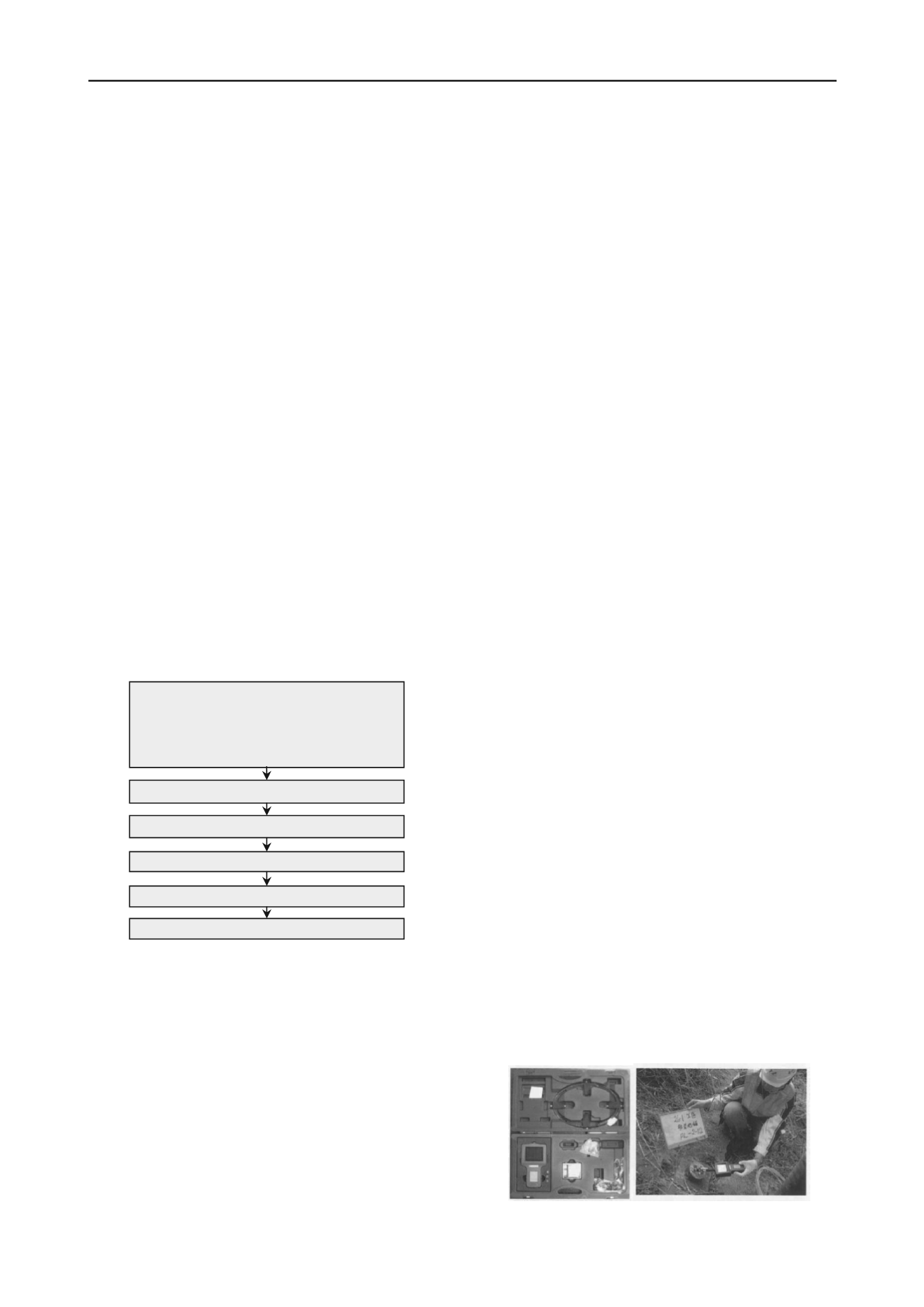
2286
Proceedings of the 18
th
International Conference on Soil Mechanics and Geotechnical Engineering, Paris 2013
2 INSPECTION ITEMS AND PROCEDURE
Ground anchoring inspection and assessment is aimed to
analyze and understand the performance of existing anchors and
the impact to the site and its surrounding.
2.1
Inspection items
Currently there are some initial inspection items including:
exterior inspection, anchor head inspection, endoscopy
inspection and Lift-off test, the four major itemswill be
explained in detail later.
2.2
Inspection procedure
Inspection procedure is as indicated in
Figure 2
. First gather
basic data from all sloped terrains for ground anchor index, then
remove all outgrowth on the slope, and check the entire ground
anchors for outside appearance, pressure bearing integrity and
water seepage status. According to the gathered data and
inspection results, select the most typical anchor in
characteristics of all achors, remove the concrete casing to
examine the anchor head and steel tendon closely, and record
findings. After examining the anchor, use the findings to select
partial ground anchors for endoscopy inspection to exam steel
tendon corrosion and proceed with Lift-off Test, in order to
understand the existing ground anchor Residual load(Tr).
Lastly, based on sloped terrain basic data and findings of
various test results, evaluate in totality the ground anchors
current capacity. If ground anchor capacities no longer meet the
requirement of original specifications or there are other
anomalies present which render the anchors inappropriate for
continuing usage, then a proposal is required to improve or
remediate the situation, including refurbishment, remedy,
reinforcement or reconstruction as required.
Figure 2. Ground anchor capacity assessment flowchart
3 CAPACITY INSPECTION METHOD
Various inspection category results can be used to provide as
the basis for evaluating the capacity of anchors, summary of
each categories is as follows:
3.1
Exterior inspection
Prior to knocking off the ground anchor concrete protected
seats, obtain as-built drawings to mark off each and every
anchors with numeric identifications. Visually inspect,
investigate and record all anchor protected seats and load
bearing structure system conditions. Visual inspection should
emphasize on 1) anchor head protected seat hammer knocking
test and the quality of sound whether solid or hollow, 2)
visually inspect exterior of anchor protected seat for any
damages, 3) between anchor head and load bearing structure,
look for any sign of separation, rotation, or even detachment, 4)
Whether subsoil below shows sign of cave-in for the load
bearing structure and 5) anchor head proximity has sign of
efflorescence or ground water seepage, and all visual inspection
should be carefully documented.
3.2
Anchor head assembly inspection
Anchor head assembly includes locking mechanism(wedges and
screw head), load bearing plate and angle plate, as such parts
tend to have anomalies. When inspecting anchor head
assembly, carefully select a representative anchor head, after the
removal of concrete protected seat, visually inspect the
corrosive state of the anchor heads. After removal of anchor
head protected seat the following category of items need to be
recorded: load bearing plate dimension, angle plate dimension,
load bearing plate angle, anchor head dimension, steel tendon
style and remaining length data.
At this stage visual inspection should emphasize on 1)
anchor head wedges and steel tendon corrosion, 2) anchor head
assembly and water seepage condition and 3) steel tendon
interior shortening, and all inspection should be recorded in
detail.
3.3
Endoscopy inspection
Endoscopy can be used to inspect the backside of anchor head
and free section of steel tendon, to determine whether the steel
tendon is corroded, broken or free section has water inside.
Entire inspection process should be video recorded to allow
further inspection and study back in the lab. The equipment
used is as shown in
Figure 3
.
Besides inspecting steel tendon status, this stage should
measure the steel tendon length of free section. The measuring
technique is to use a stainless steel rod to insert into the anchor
free section portion until the rod can not be inserted further, as
Figure 4
indicated. Then record the length of the rod which was
inserted, as such length can be taken as the exposed section
length.
Basic data gathering
•Construction plan or as-built plan
•Disaster history
•Geological Report
•Construction records
�
Endoscopy inspection should emphasis on 1)steel tendon
corrosion level, 2)steel threads loosened condition, 3) free-
section concrete condition, 4) any concrete casting pipes and 5)
interior moisture level or any water seepage, all inspection
processes should be done carefully and in detail.
Exterior inspection
Anchor head assembly inspection
3.4
Lift-off test
After locking in load bearing of ground anchors, it’s possible
that due to creep at the bond end, wedges not properly function
which would reduce or increase the loading capacities. To
measure the change of loading capacities after lock-in, typical
lift-off test is conducted, as shown in
Figure 5.
Lift-off test is
aimed at finding the remaining load capacity of anchor(Tr), and
the reason being when tensile load is greater than the anchor
remaining capacty, anchor will demonstrate obvious
displacement increase, from which can be taken to evaluate the
remaining capacity of ground anchors, as shown in a standard
test curve in
Figure 6
. Ground anchor residual load(Tr) divided
by ground anchor original designed load capacity (Tw) is the
remaining load capacity ratio.
Endoscopy inspection
Lift-off test
Anchor capacity assessment
Figure 3. Equipment installation and operation


